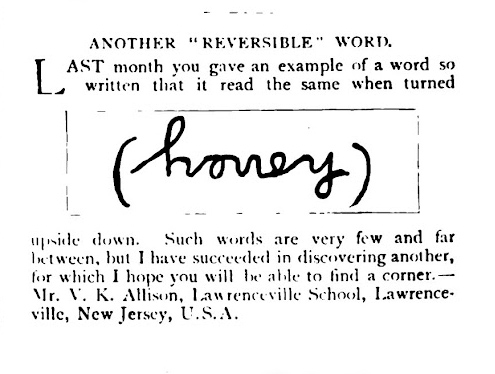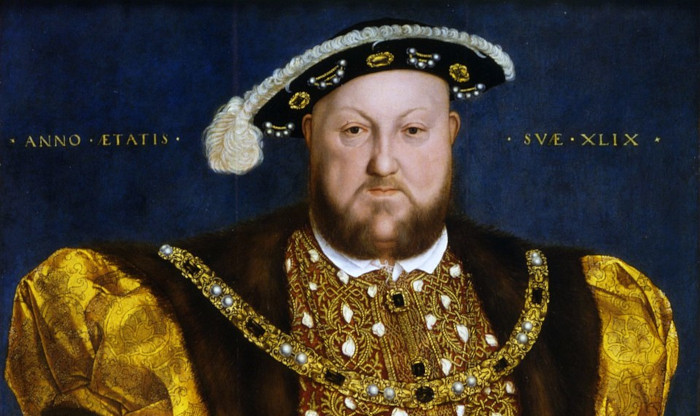An invertible word made of impossible letters, by Basile Morin:

An emphatic assertion by Douglas Hofstadter:

In 1908, after observing that chump in cursive reads largely the same upside down, the Strand asked for similar specimens and received this:

An invertible word made of impossible letters, by Basile Morin:

An emphatic assertion by Douglas Hofstadter:

In 1908, after observing that chump in cursive reads largely the same upside down, the Strand asked for similar specimens and received this:

Writing in the New Yorker in 1949, John Davenport documented a rising language he’d observed among his countrymen. He called it Slurvian. “When Slurvians travel abroad, they go to visit farn (or forn) countries to see what the farners do that’s different from the way we Murcans do things. While in farn countries, they refer to themselves as Murcan tersts, and usually say they will be mighty glad to get back to Murca.”
bean. A living creature.
course. A group of singers.
fiscal. Pertaining to the body, as opposed to the spurt.
line. King of the beasts.
myrrh. A looking glass.
plight. Courteous.
sport. To hold up, to bear the weight of.
wreckers. Discs on which music is recorded for phonographs.
Writing in the Saturday Review in 1970, Cleveland Amory noted a similar phenomenon in the national pastime:
The pisher no longer goes inna wineup, but a stresh. The firss pish is stry one, followed by ball one. Then stry two, ball two, ball three — the full cown. The ba–er fouls one inna the stanns an the cown remains aa three an two. Finally he flies deep to the senner feeler who makes a long run anna fine runnen catch up againssa wall, beyonna warneen track.
Charles Craik of Weston-super-Mare received this enigmatic postcard from a friend in 1901 and sent it on to the Strand:
I think it rather cleverly done, and it took me some time before I could understand its meaning.
The principal message is on the big island in the centre of the map — an invitation to meet the sender at a café, with the day. The name of the island below on the left-hand side is at once translated, ‘If so, do.’ The names of the land at the bottom of the map are meant for ‘Same time and place as before’ and ‘Don’t let anything hinder you’ respectively.
The following is a translation beginning at the top and working to the right: ‘Straights of cash. If you don’t come, all sorts of ills befall you. Come early. Let me know if you can come or not. I say, there’s a peculiar thing! You’re getting it by degrees. Can’t you see? Bay rhum. Get your hair cut! Deuced bad straights. See you later. Don’t you see? Devil take you. You are a merry cus! Good old flipper. Love to all. Oh! Tut, tut. R.S.V.P. Yours ever, Guy.’
But despite the gaiety of his song, Balso did not feel sure of himself. He thought of the Phoenix Excrementi, a race of men he had invented one Sunday afternoon while in bed, and trembled, thinking he might well meet one in this place. And he had good cause to tremble, for the Phoenix Excrementi eat themselves, digest themselves, and give birth to themselves by evacuating their bowels.
— Nathanael West, The Dream Life of Balso Snell, 1931

While at Eton, Winston Churchill’s son Randolph was “immensely impressed” to hear his friend Freddie Furneaux recite the following passage without notes. Ostensibly it describes Henry VIII:
“This monarch was sincere, open, gallant, liberal, intrepid, inflexible and courageous; but with these virtues he combined the vices of violence, cruelty, profusion, rapacity, obstinacy, injustice, arrogance, presumption and conceit.”
When Churchill asked the source of the quotation, Furneaux said, “I had it from the headmaster of my private school, but he did not disclose where it came from.”
That’s from Churchill’s 1965 autobiography Twenty-One Years. The only other mention I can find is in Linda Kelly’s 2017 commonplace book Consolations, where she calls it a memory test and adds, “The test is to recite it by heart after looking at it once.” That’s all I’ve managed to learn.
05/22/2025 UPDATE: Reader Charlotte Fare found a variant of the quote in Volume III of David Hume’s History of England:
A catalogue of his vices would comprehend many of the worst qualities incident to human nature: Violence, cruelty, profusion, rapacity, injustice, obstinacy, arrogance, bigotry, presumption, caprice: But neither was he subject to all these vices in the most extreme degree, nor was he, at intervals altogether destitute of virtues: He was sincere, open, gallant, liberal, and capable at least of a temporary friendship and attachment.
(Thanks, Charlotte.)

An odd detail from the autobiography of Bertrand Russell:
“The summers of 1903 and 1904 we spent at Churt and Tilford. I made a practice of wandering about the common every night from eleven till one, by which means I came to know the three different noises made by night-jars.”
He adds, “(Most people only know one.)” He says nothing more.
In a set of weights, no weight exceeds 10 kg. If the set is divided arbitrarily into two groups, the combined mass of one of these groups also will not exceed 10 kg. What’s the greatest possible mass of the full set of weights?

“A red rose absorbs all colours but red; red is therefore the one colour that it is not.” — Aleister Crowley, of all people
Some personal names used in the land moiety of the Miwok people of Northern California, listed in Brian Bibby’s Deeper Than Gold: Indian Life in the Sierra Foothills, 2005:
akaino: bear holding its head up
engeto: bear bending its foot in a particular manner while walking
esege: bear showing its teeth when cross
etumu: bear warming itself in the sun
sutuluye: bear making noise climbing up a tree
hateya: bear making tracks in the dust
katcuktcume: bear lying down with paws folded, doing nothing
laapisak: bear walking on one place making ground hard
lilepu: bear going over a man hiding between rocks
mo’emu: bears sitting down looking at each other
peeluyak: bear flapping its ears while sitting down
sapata: bear dancing with forefeet around trunk of a tree
tulmisuye: bear walking slowly and gently
utnepa: bear rolling rock with foot when pursuing something
yelutci: bear traveling among rocks and brush without making noise
notaku: growling of bear as someone passes
tulanu: two or three bears taking food from one another
semuki: bear looking cross when in its den
molimo: bear going into shade of trees
tcumela: bears dancing in the hills
Edward Winslow Gifford gives another list in Miwok Moieties, 1916.
Paris newspapers once carried an ad offering a cheap and pleasant way of travelling for the price of 25 centimes. Several simpletons mailed this sum. Each received a letter of the following content:
‘Sir, rest at peace in bed and remember that the earth turns. At the 49th parallel — that of Paris — you travel more than 25,000 km a day. Should you want a nice view, draw your curtain aside and admire the starry sky.’
The man who sent these letters was found and tried for fraud. The story goes that after quietly listening to the verdict and paying the fine demanded, the culprit struck a theatrical pose and solemnly declared, repeating Galileo’s famous words: ‘It turns.’
— Yakov Perelman, Physics for Entertainment, 1913